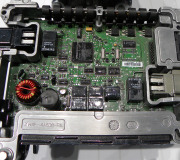Why would you think the PCM is bad? I read that the voltage is regulated by a voltage regulator, not the PCM. Check wiring harness and voltage regulator. Test this way.
ON-VEHICLE TESTING
ALTERNATOR PERFORMANCE TESTING
1. If battery is overcharged go to BENCH TESTING. If battery is undercharged, check
alternator wiring harness connections and drive belt tension. Ensure battery is fully charged.
Connect a voltmeter to alternator "B" terminal and ground. Connect ammeter positive lead to
alternator "B" terminal. Connect ammeter negative lead to positive side of battery and start
engine.
2. With all accessories off, increase engine speed from idle to 2000 RPM and read meters.
Voltmeter reading should be 14.4-15.0 volts at 68°F (20°C). Voltage reading will vary
depending on regulator case temperature. Ammeter should read about 10 amps. Turn engine
off.
3. If voltage is higher than standard value, check brush ground. See BENCH TESTING. If
brush ground is okay, replace IC regulator.
4. Load test with engine running at 2000 RPM and headlights and heater blower motor on. If
current is less than 20 amps, go to BENCH TESTING.
CAUTION: DO NOT confuse polarities of IG terminal and "L" terminal. DO
NOT create a short circuit between IG terminal and "L" terminal.
Always connect these terminals through a test light. DO NOT
connect a load between "L" and "E" terminals.
Thursday, December 30th, 2010 AT 1:57 AM




